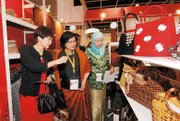China and India Prepare for 2005
HONG KONG—China was not the only country setting its sights on the United States as a new frontier for apparel exports at Hong Kong Fashion Week, held July 13–16 at the Hong Kong Convention & Exposition Centre. India was also betting that the elimination of quotas next year will pry open a door for items, such as cotton clothing, that have been restricted by quotas for decades. The number of Indian exhibitors at the Hong Kong Fashion Week for Spring/Summer 2005 was up 73 percent over last year, with 90 Indian companies testing the market.
Trade experts have already noted that India’s garment industry is poised to be one of the principal winners when quotas among the 147 World Trade Organization members disappear on Jan. 1, 2005.
With a burgeoning population of 1 billion people, second only to China’s 1.3 billion, India has thousands of workers eager for apparel industry jobs that pay approximately $80 to $100 a month. India, opposed to China, has a large number of people who speak English, which enables them to negotiate deals easily with buyers from the United States and around the world.
Many Indian apparel companies have already made major inroads into Europe, which dropped its apparel quotas to India a few years ago. Now, many Indian companies are expanding their facilities or building new factories in anticipation of added opportunities to sell to the United States.
That’s the plan for Indu Sadh, who started Indu Fashions in 1987. “We have a stronghold on Europe, and now we want to go back to the United States,” Sadh said.
Sadh’s apparel had been sold at Pier 1 Imports until that company stopped carrying clothing to concentrate on furniture and home goods. Sadh briefly transferred her manufacturing operations from New Delhi, India, to Kathmandu, Nepal, which had a better quota arrangement with the United States. But since 1995, she has been manufacturing her gauzy skirts and shirts, scarves, and dresses in New Delhi, where her factory employs 300 people. Because 85 percent to 90 percent of her business is done in Europe, it only makes sense to move back to the United States, she said.
Expansion was on the mind of K.S. Sandhu, a partner in JDM Overseas Pvt. Ltd., a New Delhi company that made its first appearance at the Hong Kong trade show. Sandhu’s enterprise has been supplying men’s shirts to J.C. Penney Co. Inc. and Pierre Cardin with a 60- to 75-day turnaround period. JDM has made the shirts primarily from a synthetic combination that has allowed the company to skirt quota restrictions. Now that Sandhu and his partner are adding a new factory that will employ 700 to 800 people in addition to the 200 people who work at their current factory, they are banking on the U.S. market to keep their new employees busy.
Before the fair, Sandhu had completed agreements to do work for Wal-Mart Stores Inc. and the Target Corp.
Still, many Indian factory owners at the show were disappointed with the number of buyers placing orders. “We have yet to see any really good buyers or mass buyers,” Sandhu said, although he did pledge to return to Hong Kong Fashion Week next January, when the turnout is traditionally much larger than in July.
According to Hong Kong Fashion Week organizers, the show saw record-breaking attendance on opening day, when more than 5,300 people showed up, a 41 percent increase over last year. Organizers said 15,000 people registered to attend, compared with 12,858 last year.
Of course, India is not the only country counting on expansion to the United States. China, with 177 booths, also upped its presence by 43 percent over last year.
However, the Chinese were taking a “let’ssee- what-happens” approach to the elimination of quotas. Martin Liu, a sales representative for Nanjing Textiles Import & Export Co. Ltd., which produces mostly fashion T-shirts and other women’s apparel, was not counting exclusively on the United States for any new business.
“I think there will be some changes [in quotas] next year but not that much,” Liu observed. “An agreement is nothing.”
But other Chinese manufacturers were more optimistic. Jack Huang, a representative of Nantong Xinlai Silk Garments Co. Ltd., said his company—which makes men’s pants and jackets and women’s pants, skirts and coats— is spending $1 million to expand its factory from 800 to 1,000 workers during the next two years.
“Right now, Europe is our strongest market,” Huang said. “But with no quotas, business should be better next year in the U.S.”
—Deborah Belgum























